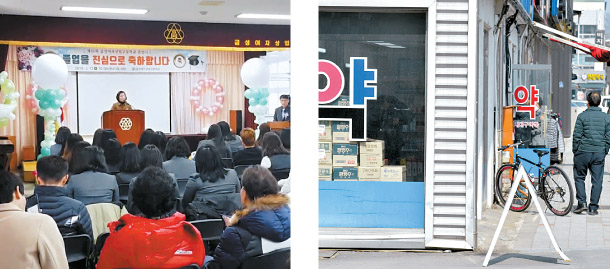Team Kim’s home is at risk of disappearing

Left: The last graduation ceremony of Keumsung Girls’ Commercial High School on Feb. 12. It is the fourth high school in Uiseong County, North Gyeongsang, to be closed due to a lack of students. Right: A pharmacy near Uiseong Station and its intercity bus terminal. There are many medical facilities and hospitals near the area. [KIM SUNG-TAE]
The home of Team Kim, the curlers who were Korea’s brightest stars in the 2018 PyeongChang Olympics, tops the list of the country’s 226 municipalities in terms of its depopulation risk. With most young men and women heading to bigger cities, the average age of residents has skyrocketed to 56. The county is struggling to help its residents that are holding out, but the future does not seem bright, as the area lacks maternity and medical facilities. It is fast becoming a place of empty playgrounds, and has a mortality rate that is four times the birthrate.
“The number of births since 2013 was about 200, whereas the number of deaths was about 800, a fourfold difference,” said an Uiseong representative. The average age in the county is 14 years older than the national average of 42 and 38.8 percent of the population is over 65.
Lee Sang-ho, manager of Korea Employment Information Service, warned that Uiseong is facing depopulation. His research is based on a method created by Hiroya Masuda, the former Minister of Internal Affairs of Japan, which assesses the state of areas by dividing the number of women within the area between the ages of 20 to 39 with people over 65. Municipalities with results from 0.2 to 0.5 are classified as “at risk” and results under 0.2 are classified as “at high risk.” Uiseong had the lowest score in the country at 0.151.
Part of this is due to the large number of women of childbearing age moving out of the county. Though Uiseong is twice the size of Seoul, it has not a single delivery room or postnatal care center. The only outpatient maternity hospital in the area is in the village of Angye-ri, but it only performs predelivery examinations.
“Eight mothers come to us each month,” said Oh Dong-kyu, the head of the maternity hospital. Children are mostly delivered at hospitals in adjacent cities like Daegu or Andong. Research published in the January issue of the Korean Academy of Medical Sciences journal shows that women in areas with poor maternity conditions are three times more likely to suffer miscarriages than in other places.
Uiseong is also a bad place to get hurt, with only two emergency medical facilities - the hospital in Angye-ri and a county clinic.
“Most emergency patients are in their 70s and 80s, and about 10 come here daily,” said hospital personnel. The county has four hospitals with over 30 sickbeds, 18 general practitioners and six nursing hospitals. The abundance of nursing hospitals compared with regular hospitals reflects the aging population of the county.
In a graduation ceremony on Feb. 12, 28 graduates waited in the auditorium for their grand moment at Keumsung Girls’ Commercial High School. They are the last graduates of the school, which will be closing shortly after.
“With this last graduation ceremony, our school will close down and disappear from history,” said Park Ran-hee, one of the school’s first graduates.
This high school is the fourth in Uiseong to be closed down. Only three of the 28 graduates are originally from the county, with the others coming from nearby counties to Uiseong to attend school. Since 1983, Uiseong has lost 17 elementary schools, five middle schools and 37 small regional schools located in rural districts.
The disappearance of schools is only one of the problems in Uiseong’s education system. The schools that are still running are barely managing to get by. Uiseong’s Oksan Middle School has a total of nine students. Now that a first year student has transferred to another school before the start of the semester, the school does not have a single second-year student.
In an attempt to revive the area, the local government of North Gyeongsang is planning to build what it calls a “neighborhood youth trial village” in Angye-ri, Uiseong. The village is a compound of welfare, workplaces, residences and culture facilities, and 1.7 billion won ($1.5 million) is budgeted for its construction. Local authorities plan to make smart farms, food industry clusters and a residential area that can accommodate 100 families by 2022. The plan aims to eventually increase Uiseong’s population by 2,500.
“Without support from the central government, provincial small and medium-sized cities will become a black hole that draws in the government’s assets,” said Mi Kang-rae, a professor of urban planning and real estate at Chung-Ang University. “The decline of the provinces will result in the collapse of the whole country.”
BY OH YOUNG-HWAN and JUNG MYUNG-SUK [jung.myungsuk@joongang.co.kr]










with the Korea JoongAng Daily
To write comments, please log in to one of the accounts.
Standards Board Policy (0/250자)